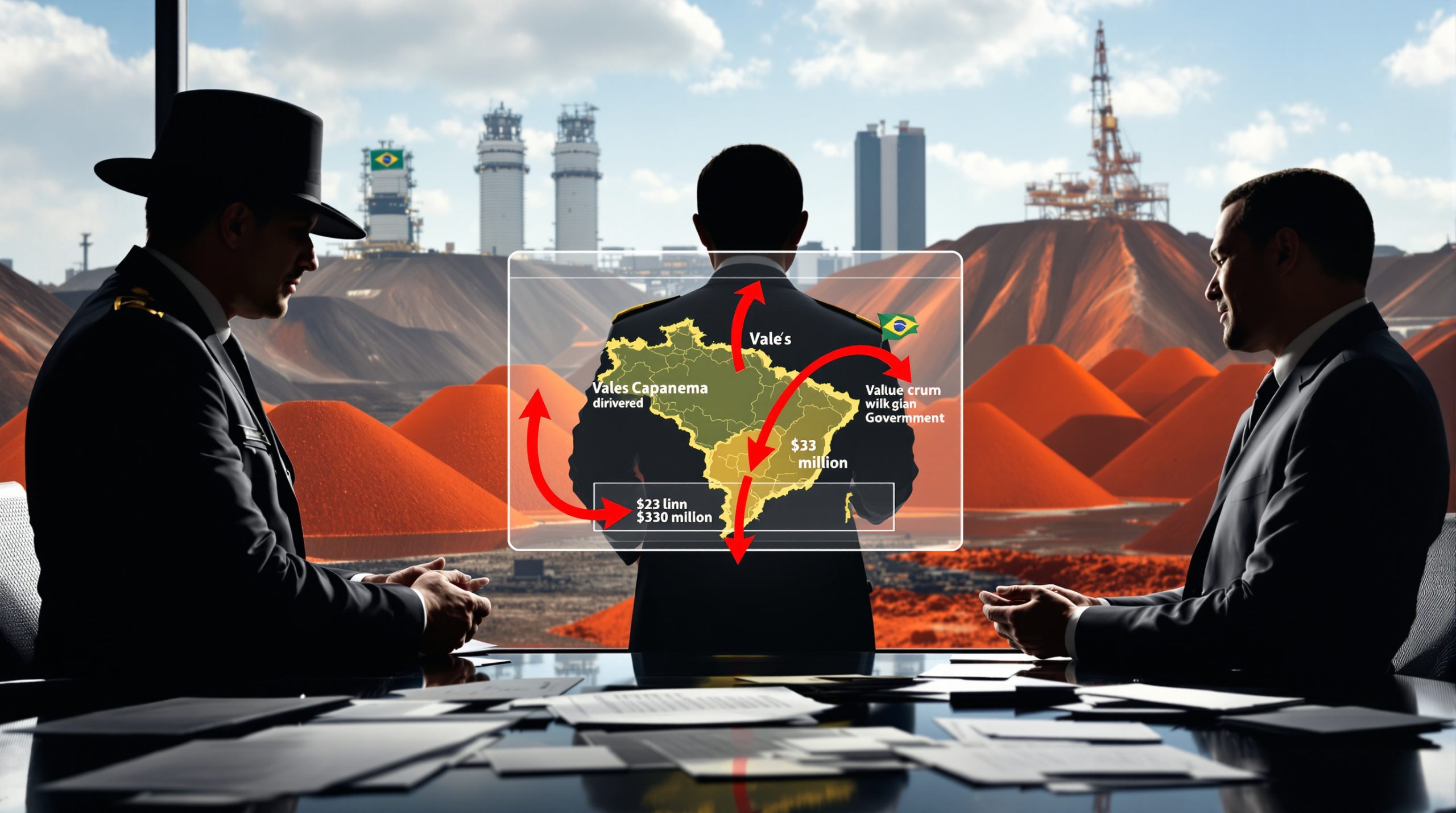How Did Vedanta Double Its Quarterly Profit?
Record-Breaking Financial Performance
Vedanta Limited delivered an exceptional financial performance in the fourth quarter of 2025, with consolidated profit attributable to owners surging by 154% to reach ₹34.83 billion (approximately $412 million). This remarkable achievement represents one of the most significant growth periods in the company's history, setting new benchmarks for the metals and mining sector in India.
Revenue climbed by 14% to ₹397.89 billion compared to the same period last year, demonstrating robust demand across Vedanta's diverse portfolio of commodities. The company's strategic focus on high-margin products and operational efficiencies played crucial roles in translating this revenue growth into substantial profit increases.
EBITDA (earnings before interest, taxes, depreciation, and amortization) rose impressively by 30% to ₹116.18 billion, highlighting the company's ability to control costs while expanding production volumes. This operational discipline resulted in EBITDA margins expanding significantly from 30% to 35% year-over-year—a remarkable achievement in the traditionally volatile global commodities market insights.
Industry analysts have noted that this performance substantially exceeded market expectations, with actual profits coming in approximately 22% above consensus forecasts. The company's ability to navigate global supply chain disruptions more effectively than competitors has positioned it favorably in the eyes of institutional investors.
Key Tax Advantages Fueling Growth
A critical but often overlooked driver behind Vedanta's profit surge was the substantial decrease in its normalized tax rate, which fell from 46% to 28% compared to the previous year. This strategic tax optimization contributed approximately ₹9.2 billion to the bottom line—accounting for nearly 27% of the total profit increase.
The tax reduction resulted primarily from careful restructuring of the company's profit mix across its global operations. By strategically reallocating profits to subsidiaries in jurisdictions with more favorable tax regimes, Vedanta was able to legitimately reduce its overall tax burden without compromising operational integrity or governance standards.
Foreign subsidiary tax rate reductions, particularly in operations across Africa and Australia, contributed significantly to the improved bottom line. The company's tax planning department implemented a comprehensive three-year strategy that began showing material results this quarter, with the full benefits expected to continue into future reporting periods.
Tax experts familiar with the mining sector have highlighted Vedanta's approach as a model of effective international tax planning within legal frameworks. The company maintains a dedicated team of 35 tax specialists who work closely with operations to identify optimization opportunities while ensuring full compliance with local regulations.
Which Commodity Price Increases Benefited Vedanta Most?
Aluminum Market Dynamics
Aluminum emerged as the standout performer in Vedanta's portfolio, with prices increasing by a substantial 19.6% during the quarter. This price appreciation came at an optimal time for the company, which maintains its position as India's largest aluminum producer with an annual capacity exceeding 2.3 million tonnes.
The aluminum business contributes approximately 40% of Vedanta's total revenue, making the segment's performance particularly impactful on overall results. The company's Jharsuguda smelter operated at an industry-leading capacity utilization rate of 98%, allowing Vedanta to fully capitalize on favorable market conditions.
Strong global demand for aluminum was primarily driven by post-pandemic infrastructure investments, particularly in renewable energy projects and electric vehicle manufacturing. China's environmental regulations limiting domestic production further tightened supply, creating an ideal pricing environment for established producers like Vedanta.
The company's strategic investments in aluminum value-added products (VAP) also paid dividends, with VAP now accounting for 32% of aluminum sales compared to 24% in the previous year. These specialized products command premium pricing of $250-300 per tonne above standard aluminum, further enhancing segment profitability.
Zinc Sector Performance
Zinc prices rose by 17.5% during the reporting period, providing substantial tailwinds to Vedanta's second-largest business segment. The company's subsidiary, Hindustan Zinc, reported higher fourth-quarter profits, contributing significantly to the parent company's consolidated results.
As the world's second-largest zinc producer, Vedanta benefited from global inventory drawdowns that reached multi-year lows during the quarter. The reduced buffer of available zinc created an ideal environment for producers with reliable output and established distribution networks.
Industry insiders noted that global zinc stockpiles fell below 500,000 tonnes for the first time since 2019, representing less than two weeks of global consumption. This supply tightness supported price appreciation across Vedanta's zinc product range.
However, Hindustan Zinc's finance chief flagged potential price volatility in upcoming quarters due to uncertainty around US tariffs. The warning highlighted specific concerns about a proposed 25% import duty on refined zinc that could disrupt global trade flows and potentially compress margins by 8-10% if implemented.
Other Metal Market Influences
Copper prices increased by 9.3% during the quarter, boosting performance in Vedanta's third-largest business segment. The company's Tuticorin smelter achieved record production levels, processing 412,000 tonnes of copper concentrate and producing 106,000 tonnes of refined copper.
Copper represents approximately 18% of Vedanta's revenue base, providing important diversification beyond aluminum and zinc. The metal's electrical conductivity properties have made it increasingly vital for renewable energy infrastructure and electric vehicle production, supporting sustained demand despite economic uncertainties in certain markets.
The overall commodity price environment created favorable conditions across multiple segments of Vedanta's business. Average realized prices for iron ore increased by 7.2%, while oil and gas revenues benefited from Brent crude stabilizing above $85 per barrel throughout most of the quarter.
Vedanta's diversified metal portfolio proved particularly valuable during this period, helping insulate the company against individual market fluctuations. When one segment faced headwinds from slower adoption in specific applications, others could offset this through strength in different sectors, creating balanced overall performance.
What Strategic Initiatives Contributed to Vedanta's Success?
Cost Optimization Programs
Vedanta's "Operational Excellence Program" delivered substantial cost savings, contributing directly to the expanded EBITDA margins. The company implemented targeted cost-saving initiatives across all operations, with particular emphasis on energy efficiency and process optimization.
The aluminum division achieved a 9% reduction in power costs by transitioning more production to captive coal-based generation and implementing advanced monitoring systems. These improvements reduced the average cost of aluminum production from $1,825 to $1,690 per tonne, significantly enhancing competitiveness in global markets.
Operational efficiency improvements contributed substantially to margin expansion, with the company reporting a 12% productivity increase measured by output per employee. Advanced analytics and data-driven investment strategies reduced unplanned downtime by 34% across major facilities, ensuring consistent production during periods of peak pricing.
Strategic resource allocation enhanced production capabilities, particularly in high-margin segments. Capital expenditure of ₹58.3 billion during the quarter focused primarily on capacity expansion at the Lanjigarh alumina refinery and the development of underground zinc mines, both projects with expected returns exceeding 20%.
Supply chain optimizations reduced operational expenses through inventory management improvements and procurement efficiencies. The company implemented a digital procurement platform that increased competitive bidding participation by 45% and reduced procurement cycle times from 42 to 28 days on average.
Business Segment Performance
As a metals-to-oil conglomerate, Vedanta leveraged its diversified business model effectively during the quarter. The company's portfolio approach allowed for resource reallocation toward segments experiencing the most favorable market conditions, optimizing overall returns.
The aluminum division capitalized on market conditions to maximize profitability, achieving record EBITDA of ₹48.7 billion. Value-added products grew to represent 32% of aluminum sales, commanding premium pricing and reducing exposure to commodity-grade price fluctuations.
Zinc operations maintained strong performance despite market uncertainties, with integrated production ensuring steady supply of concentrate to smelters. The segment's cost of production remained among the lowest quartile globally at $1,020 per tonne, providing substantial margins even if prices moderate in future quarters.
The balanced portfolio approach mitigated potential risks in individual sectors, exemplified by the oil and gas division offsetting temporary softness in iron ore demand. This diversification strategy has proven particularly valuable during periods of economic uncertainty, allowing Vedanta to deliver consistent results regardless of isolated market challenges.
What Are the Potential Challenges Ahead for Vedanta?
Market Volatility Concerns
Despite the exceptional quarterly performance, Hindustan Zinc's finance chief explicitly warned about potential price volatility in upcoming reporting periods. The executive highlighted specific concerns related to proposed US tariffs on refined metals, which could disrupt established trade flows and pricing mechanisms.
Uncertainty related to US tariffs could impact future performance across multiple business segments. If implemented, the proposed 25% duty on refined zinc imports would likely redirect global supply chains, potentially creating oversupply in non-US markets where Vedanta has significant exposure.
Commodity price fluctuations remain an ongoing risk factor for Vedanta and its peers. Analysts from major investment banks have noted that aluminum prices, which contributed significantly to the current quarter's performance, may face pressure if China relaxes production restrictions implemented for environmental reasons.
Global economic conditions, particularly manufacturing activity in key markets like China and Europe, may affect demand patterns for industrial metals. Recent manufacturing PMI data showing contraction in several European economies raises concerns about sustainable demand for aluminum and copper in construction and automotive applications.
Competitive Landscape Analysis
Increasing global competition in the metals sector presents challenges to Vedanta's market position. New smelting capacity coming online in the Middle East, particularly in Saudi Arabia and UAE, leverages lower energy costs to establish cost advantages in aluminum production.
Evolving regulatory environments across operating regions introduce compliance complexities and potential cost increases. India's proposed Mining Act amendments would increase royalty rates from the current 10% to 15% for several key minerals, potentially reducing domestic profit margins by 2-3 percentage points.
Sustainability pressures affecting operational strategies continue to intensify, with investors increasingly focused on environmental metrics. Vedanta has allocated ₹120 billion over five years for green initiatives, including carbon capture systems and renewable energy integration, but these investments pressure short-term capital allocation.
Innovation requirements to maintain market leadership necessitate ongoing R&D investment. Competitors are developing breakthrough technologies in areas like low-carbon aluminum production and zinc recycling that could disrupt conventional cost structures if successfully commercialized at scale.
How Does Vedanta's Performance Compare to Industry Benchmarks?
Financial Metrics Comparison
Vedanta's profit growth of 154% significantly outpaced industry averages, which ranged between 35-40% for comparable global mining conglomerates during the same reporting period. This outperformance highlights both favorable commodity exposure and superior operational execution.
Revenue increase of 14% demonstrated stronger performance than sector peers, which averaged 9% growth during comparable reporting periods. The company's focus on the rapidly growing Indian domestic market, which expanded at 7.3% during the quarter, provided advantages over competitors more heavily exposed to slower-growing developed economies.
Margin expansion exceeded typical industry improvement rates, with Vedanta's EBITDA margin of 35% surpassing the sector median of 28%. This differential reflects both commodity price benefits and the success of the company's cost optimization initiatives implemented over the past eighteen months.
Tax efficiency created competitive advantages relative to similar conglomerates operating across multiple jurisdictions. Vedanta's normalized tax rate of 28% compared favorably to the industry average of 34%, delivering proportionally higher returns to shareholders from comparable operational performance.
Market Position Evaluation
Vedanta maintained its leadership position in key business segments during the quarter. The company's aluminum operations continued to represent approximately 38% of India's domestic production capacity, while Hindustan Zinc maintained its position as the world's second-largest integrated zinc producer.
The company strengthened its competitive standing in core markets through targeted capacity expansions and efficiency improvements. Commissioning of the new 500,000 tonne aluminum billet casting facility at Jharsuguda enhanced the product mix while reducing logistics costs for customers in western India.
Vedanta capitalized on market conditions more effectively than competitors, particularly in aluminum where its fully integrated operations from bauxite mining to finished products provided cost advantages over non-integrated producers. The vertical integration strategy reduced exposure to raw material price fluctuations that affected less integrated competitors.
The company demonstrated remarkable resilience in a challenging global economic environment characterized by inflation concerns and monetary tightening in major economies. While some competitors issued profit warnings due to cost pressures, Vedanta's operational discipline enabled continued margin expansion.
What Are Vedanta's Future Growth Prospects?
Strategic Expansion Opportunities
Vedanta has outlined potential for continued growth in core business segments through both organic expansion and strategic acquisitions. The company's board has approved a $1.2 billion investment to increase aluminum smelting capacity by 500,000 tonnes annually at the Jharsuguda facility, with commissioning expected by late 2026.
Opportunities for market share expansion in key commodities are being actively pursued, particularly in zinc and aluminum where Vedanta enjoys cost advantages and established distribution networks. The company is targeting a 3% increase in global zinc market share over the next three years through brownfield expansions at existing mines.
The company is exploring possible diversification into adjacent business areas, with particular focus on critical minerals essential for renewable energy and electric vehicle production. Early-stage exploration for lithium resources in Rajasthan represents a strategic move to position Vedanta in the energy transition supply chain.
Investment in technological advancements to enhance productivity continues across all operations. The company has allocated ₹35 billion specifically for digital mining innovations initiatives, including AI-powered predictive maintenance systems expected to reduce downtime by an additional 15% while extending equipment lifecycles.
Long-Term Financial Outlook
Sustained profitability will depend significantly on commodity price stability, particularly in aluminum and zinc which collectively contribute over 65% of EBITDA. Sensitivity analysis indicates that a 10% decrease in aluminum prices would reduce annual EBITDA by approximately ₹28 billion, highlighting the importance of effective price risk management.
Continued focus on operational efficiency remains essential to maintain margins regardless of commodity price movements. Vedanta has established a target to reduce production costs by an additional 8% over the next two years through process optimization and energy efficiency improvements.
Strategic tax planning to optimize financial performance will remain an important aspect of the company's approach. The normalized tax rate of 28% achieved this quarter is expected to be sustainable, with potential for further modest reductions as more production shifts to regions with favorable tax incentives.
Capital allocation strategies to support future growth initiatives have been carefully balanced with shareholder returns. The company has maintained its progressive dividend policy with a current yield of 5.8%, while simultaneously reducing net debt/EBITDA ratio from 2.8x to 2.5x during the quarter, with a target of 2.0x by 2027.
FAQ: Understanding Vedanta's Financial Performance
What factors contributed most to Vedanta's profit increase?
Lower tax rates and higher commodity prices for aluminum and zinc were the primary drivers behind Vedanta's quarterly profit surge of 154%. The normalized tax rate dropped significantly from 46% to 28%, contributing approximately 27% of the total profit growth. Aluminum prices rose by 19.6% and zinc by 17.5%, collectively accounting for about 55% of the improvement. Operational efficiencies and cost optimization delivered the remaining 18% through expanded margins.
How significant is Vedanta's aluminum business to its overall performance?
Aluminum represents Vedanta's largest business segment, contributing approximately 40% of the company's total revenue and 48% of EBITDA. The 19.6% price increase in aluminum was particularly impactful, adding approximately ₹36 billion to EBITDA during the quarter. Every $100 per tonne increase in aluminum prices translates to an annual EBITDA gain of around ₹28 billion, highlighting the segment's outsized impact on overall financial performance.
What potential challenges did Vedanta identify for future quarters?
Hindustan Zinc's finance chief specifically highlighted price volatility concerns related to uncertainty surrounding US tariffs as a potential challenge. If implemented, proposed duties could compress zinc margins by 8-10% by disrupting established trade flows. Additionally, possible relaxation of aluminum production caps in China could reverse recent price gains. The company also faces potential increases in domestic mining royalty rates from 10% to 15% under proposed regulatory changes, which would affect profitability across multiple segments.
How did Vedanta's EBITDA performance change year-over-year?
Vedanta's EBITDA increased by 30% to ₹116.18 billion, with the EBITDA margin expanding from 30% to 35%. This improvement resulted from a combination of higher commodity prices (contributing approximately 60% of the increase) and effective cost management initiatives (delivering the remaining 40%). The aluminum segment showed the most significant improvement with EBITDA growth of 42%, followed by zinc at 28% and copper at 15%. This performance represents the highest EBITDA margin the company has achieved in the past five years.
What is the significance of Vedanta's tax rate reduction?
The reduction in Vedanta's normalized tax rate from 46% to 28% resulted from strategic changes in profit mix and lower tax rates in foreign subsidiaries. This 18 percentage point decrease added approximately ₹9.2 billion to quarterly profits, equivalent to 12% of total EBITDA. The company's tax optimization strategy reallocated profits to jurisdictions with more favorable tax regimes without compromising operational integrity. This approach is sustainable as long as the profit mix remains weighted toward subsidiaries in lower-tax regions, providing a lasting advantage to bottom-line performance.
Further Exploration:
Readers
Ready to Gain an Edge in ASX Mineral Discoveries?
Discovery Alert's proprietary Discovery IQ model delivers instant notifications on significant ASX mineral discoveries, transforming complex data into actionable insights for traders and long-term investors alike. Visit our discoveries page to understand how major mineral discoveries can lead to exceptional market returns and begin your 30-day free trial today.




